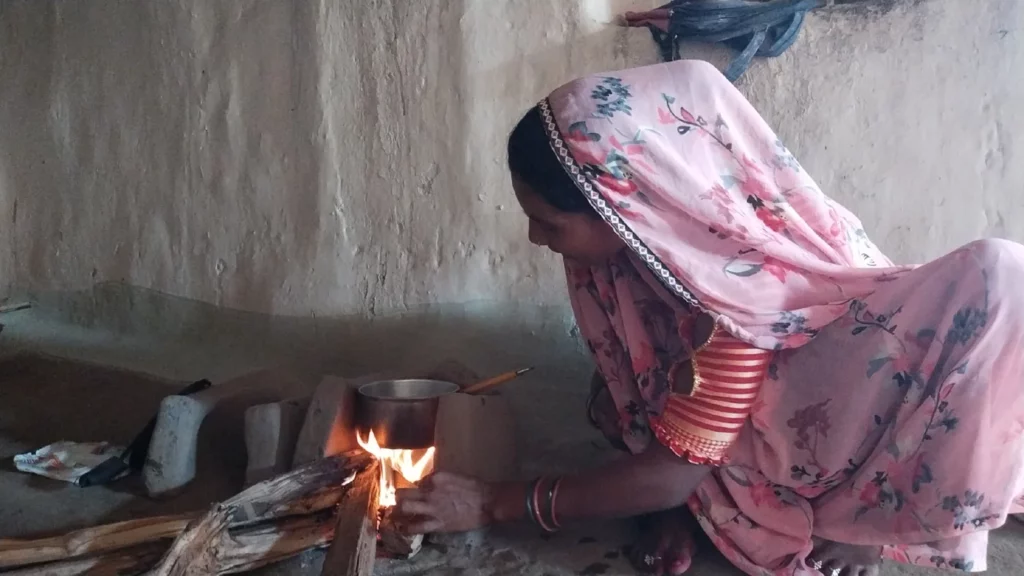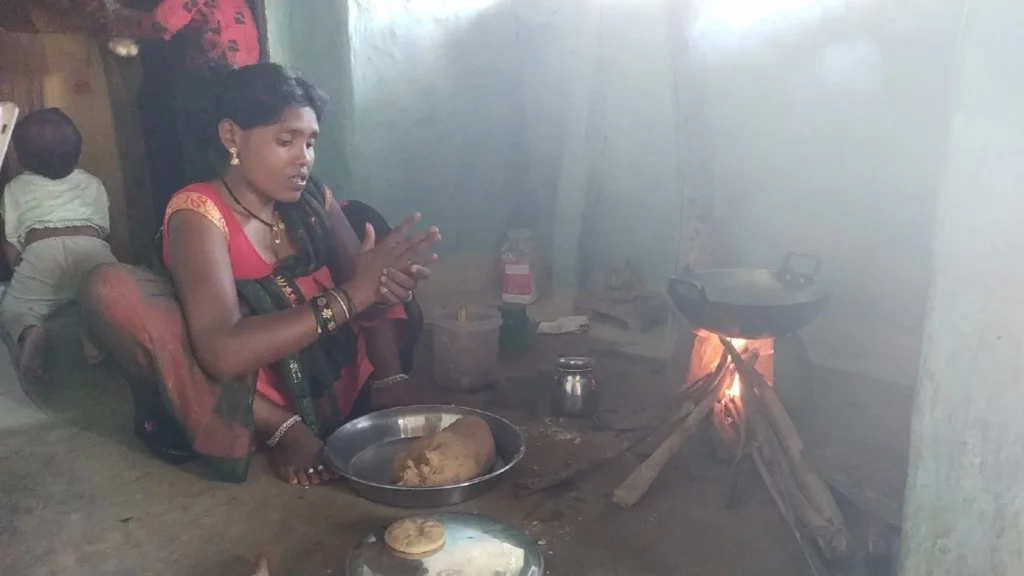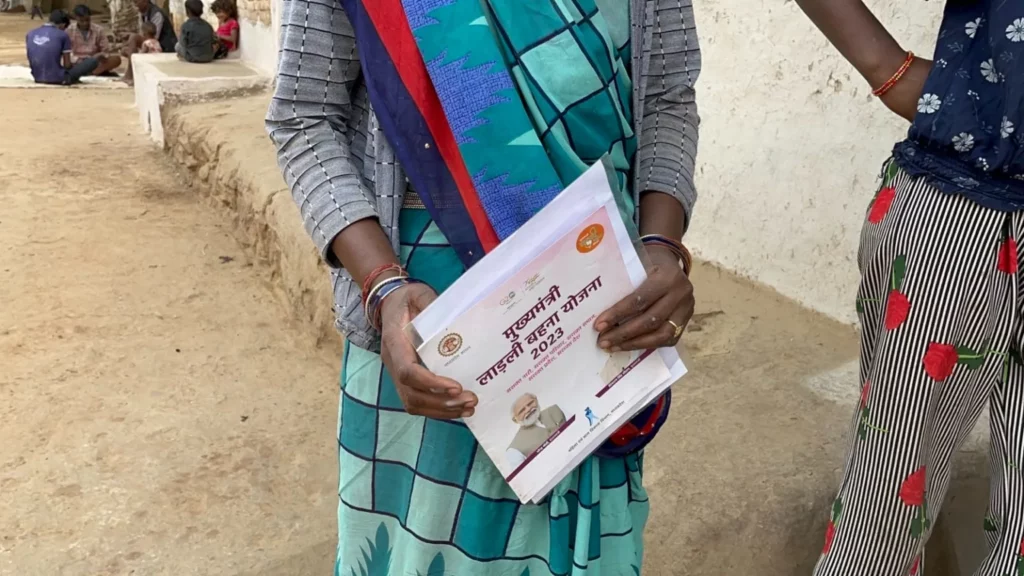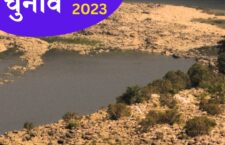The Madhya Pradesh government is going all out to woo women with special schemes. But how do the women see this outreach, we ask.

A woman outside the Kunwarpur panchayat office where applications are submitted for the Ladli Behna Yojana, Panna, Madhya Pradesh. Credits: Khabar Lahariya
The other critical scheme on which we interviewed women voters is the Ujjwala Yojana, the Centre’s flagship scheme to provide LPG connections to the underprivileged. Data from the Ministry of Petroleum and Natural Gas indicate that over 80 million LPG connections have been distributed under the scheme nationwide.
In its manifesto, the BJP has announced that LPG gas cylinders would be provided to the beneficiaries of the Ladli Behna Yojana at Rs 450 (the market price is Rs 1200-2000).
Shyama, a casual worker from Katehari village in Panna district, says she is disappointed she has not yet managed to get a Ujjwala connection. “I did everything right. I got the scheme card, and filled out the registration form, but I still didn’t receive a gas connection. I don’t really know why,” she says.
Her experience is not isolated, as many of our interviews with women suggest that many eligible beneficiaries in rural areas remain without connections for multiple reasons.
Launched in 2016, the Prime Minister Ujjwala Yojana (PMUY), popularly known as Ujjwala, is meant to promote clean cooking by enabling poor women to get gas connections. The common perception is that this scheme provides “free” gas cylinders to the poor but the reality is that the LPG connections are “given” to poor households in terms of cash assistance.

In Majhauli village, Radha, an ASHA worker, prepares food using firewood as she does not have a SAMAGRA ID card, necessary to avail schemes like Ujjwala. She finds it difficult to cook on the chulha, experiencing discomfort in her eyes and throat, often enduring burns on her fingers./Credits: Khabar Lahariya
As Behanbox reported in February this year, a rise in the price of LPG cylinders has pushed women back to traditional cooking fuels like coal and wood. Interviews with six women, mostly Dalit and migrant workers, living in three of Delhi’s low-income neighbourhoods showed that a 51.7% rise in the price of LPG refills between January 2021 and July 2022 (from Rs 694 to Rs 1053) has forced all to return, fully or partially, to traditional stoves. Gas stoves, the women said, are being used minimally for quick cooking – brewing tea, cooking rice or chapatis, for instance.
The most common complaint was that the subsidy-as-cash-transfer system was not reaching their bank accounts. The India Residential Energy Consumption Survey (IRES) 2020 stated that one-third of Indian households did not receive the subsidy for their last LPG refill or said they did not know if they had received it or not.
“The cylinder cost me Rs 1700. I have no idea about the subsidy. No one told me,” says Ratibai, a daily wage worker from Katehari village. Some women who spoke to KL are aware of the subsidy but found that using LPG as cooking fuel is a huge deterrent due to hidden costs.
“We have to spend Rs 50-70 to reach the office, which is 3-4 kms away, and that’s an added cost,” says Shyamarani, 40, from Katehari village.
In 2019, the Comptroller and Auditor General of India’s report on the scheme revealed that while the scheme successfully distributed a significant number of LPG connections, there were notable shortcomings in the implementation – irregularities in the identification of beneficiaries, delays in the installation of LPG connections, and inadequate consumer awareness leading to low refill consumption.
Shantibai, a farmer from Katehari, says only two of the 50 houses in her village have benefitted so far from the scheme. “The scheme is good, but there are other needs of ours we have been talking about for years, such as having access to basic facilities like roads and water. Without good roads, how can we refill the cylinder?” she asks.

The government’s Ujjwala Scheme provides women with cash assistance to procure LPG Cylinders. However, only a few women know of the scheme or have been able to access cylinders, leaving others to use firewood to cook food. Credits: Khabar Lahariya
This sentiment is reflected in an article in the journal Sustainability, titled “Dissemination Challenges of Liquefied Petroleum Gas in Rural India: Perspectives from the Field”. It concludes that for effective LPG supply the government needs to ensure adequate infrastructure and greater awareness.
Paanrani, 40, from Katehari, has never had an LPG connection in her kitchen. “I never registered for the scheme. I don’t know how to but it would save me a trip to the neighbouring forest every 2-3 days to collect wood for fuel,” she says.
Her neighbour, Ashokrani, 50, also still relies on wood for fuel. “My son went to fill the form, and the petrol cost of the trip was Rs 100,” she says. “But we haven’t heard back from them till now. I get the wood from the nearby forest that is 3-4 km away. The forest guards stop us if they see us so we collect the wood surreptitiously. The heat from the stove makes me sweat and the smoke gets into my eyes. But what can I do?”
[This report is a collaboration between Khabar Lahariya and Behanbox.]
Credits
Reporting: Geeta Devi and Meera Devi
Geeta Devi is the Chief Reporter at Khabar Lahariya. Her in-depth investigative reports on environmental issues, climate justice, resilience, and migration have garnered widespread acclaim.
Meera Devi is the Managing Editor of Khabar Lahariya. With 15+ years of reporting on rural issues, Meera specialises in investigative journalism and policy reporting.
Written by Hameeda Syed
Hameeda is a freelance journalist and gender consultant based in New Delhi. She’s currently a part-time writer for Khabar Lahariya.
‘यदि आप हमको सपोर्ट करना चाहते है तो हमारी ग्रामीण नारीवादी स्वतंत्र पत्रकारिता का समर्थन करें और हमारे प्रोडक्ट KL हटके का सब्सक्रिप्शन लें’


